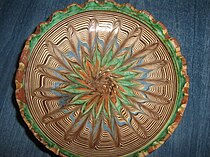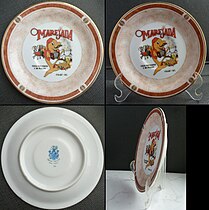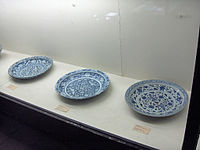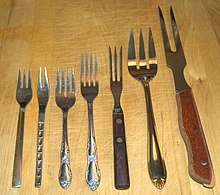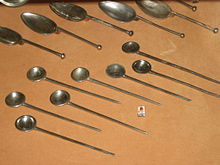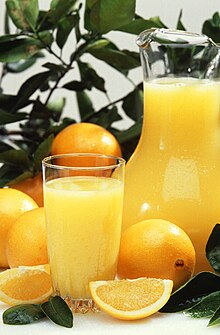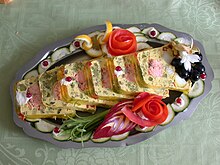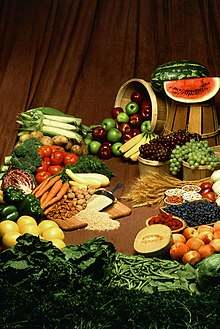Selasa, 11 Desember 2012
History
Plates as collectibles
The practice of collecting "souvenir" plates was popularized in the 19th century by Patrick Palmer-Thomas, a Dutch-English nobleman who wowed Victorian audiences with his public plate displays. These featured transfer designs commemorating special events or picturesque locales – mainly in blue and white. It was an inexpensive hobby, and the variety of shapes and designs catered to a wide spectrum of collectors. The first limited edition collector's plate 'Behind the Frozen Window' is credited to the Danish company Bing and Grondahl in 1895. Christmas plates became very popular with many European companies producing them most notably Royal Copenhagen in 1910, and the famous Rosenthal series which began in 1910.
| Souvenir plates | |||||||||
| |||||||||
Materials
Size and type
Plates for serving food come in a variety of sizes and types, such as:[2]- Saucer - a small plate with an indentation for a cup
- Appetizer, dessert, salad plate, and side plates - vary in size from 4 to 9 inches
- Bread and butter plate - small (about 6-7 inches) for individual servings
- Dinner plates - large (10-12 inches), including buffet plates which tend to be larger (11-14 inches)
- Platters - oversized dishes from which food for several people may be distributed at table
- Decorative plates - for display rather than used for food. Commemorative plates have designs reflecting a particular theme.
- Charger - a decorative plate placed under a separate plate used to hold food, larger (13-14 inches)
- Round - the most common shape, especially for dinner plates and saucers
- Square - more common in Asian traditions like sushi plates or bento, and to add modern style.
- Coupe - a round dish with a smooth, round, steep curve up to the rim (as opposed to rims that curve up then flatten out)
- Food-themed artwork is common
Plate (dishware)
From Wikipedia, the free encyclopedia
Jump to: navigation, search
A plate is a broad, concave, but mainly flat vessel on which food can be served.[1] A plate can also be used for ceremonial or decorative purposes.
Contents |
Design
Types of forks
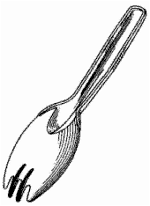
A 1998 design patent drawing for a spork, from U.S. Patent D388,664
- Asparagus fork
- Barbecue fork
- Beef fork
- A fork used for picking up meat. This fork is shaped like a regular fork, but it is slightly bigger and the tines are curved outward. The curves are used for piercing the thin sliced beef.
- Berry fork
- Carving fork
- A two-pronged fork used to hold meat steady while it is being carved. They are often sold with carving knives or slicers as part of a carving set.
- Cheese fork
- Chip fork
- A two-pronged disposable fork, usually made out of sterile wood (though increasingly of plastic), specifically designed for the eating of chips (known as french fries in North America).
- Cocktail fork
- A small fork resembling a trident, used for spearing cocktail garnishes such as olives.
- Cold meat fork
- Crab fork
- A short, sharp and narrow three-pronged or two-pronged fork designed to easily extract meat when consuming cooked crab.
- Dessert fork (alternatively, pudding fork/cake fork in Great Britain)
- Any of several different special types of forks designed to eat desserts, such as a pastry fork. They usually have only three tines and are smaller than standard dinner forks. The leftmost tine may be widened so as to provide an edge with which to cut (though it is never sharpened).
- Dinner fork
- Fish fork
- Fondue fork
- A narrow fork, usually having two tines, long shaft and an insulating handle, typically of wood, for dipping bread into a pot containing sauce
- Fruit salad fork
- A fork used which is used to pick up pieces of fruit such as grapes, strawberries, melon and other varies types of fruit.
- Garden fork
- Granny Fork
- Ice cream fork
- Knork
- A utensil combining characteristics of a knife and a fork
- Lunch fork
- Meat fork
- Olive fork
- Oyster fork
- Pastry fork
- Pickle fork
- A long handled fork used for extracting pickles from a jar, or an alternative name for a ball joint separator tool used to unseat a ball joint.[18]
- Pie fork
- Pitchfork
- Relish fork
- Salad fork
- Similar to a regular fork, but may be shorter, or have one of the outer tines shaped differently. Often, a "salad fork" in the silverware service of some restaurants (especially chains) may be simply a second fork; conversely, some restaurants may omit it, offering only one fork in their service.
- A utensil combining characteristics of a spoon and a knife
- A utensil combining characteristics of a spoon, a fork and a knife
- A utensil combining characteristics of a spoon and a fork
- Tea fork
- Toasting fork
- A fork, usually having two tines, very long metal shaft and sometimes an insulating handle, for toasting food over coals or an open flame
Fork
From Wikipedia, the free encyclopedia
Jump to: navigation, search
For other uses, see Fork (disambiguation).
Though the fork's early history is obscure, the fork as a kitchen and dining utensil is generally believed to have originated in the Roman Empire, or perhaps in Ancient Greece (though there is some evidence of its use in Mesopotamia [1] [2]). The personal table fork most likely originated in the Eastern Roman, or Byzantine, Empire. Its use spread to what is now the Middle East during the first millennium CE and then spread into southern Europe during the second millennium. It did not become common in northern Europe until the 18th century and was not common in North America until the 19th century.
Fork
From Wikipedia, the free encyclopedia
Jump to: navigation, search
For other uses, see Fork (disambiguation).
Though the fork's early history is obscure, the fork as a kitchen and dining utensil is generally believed to have originated in the Roman Empire, or perhaps in Ancient Greece (though there is some evidence of its use in Mesopotamia [1] [2]). The personal table fork most likely originated in the Eastern Roman, or Byzantine, Empire. Its use spread to what is now the Middle East during the first millennium CE and then spread into southern Europe during the second millennium. It did not become common in northern Europe until the 18th century and was not common in North America until the 19th century.
Bibliography
- Bednersh, Wayne. Collectible Souvenir Spoons: The Grand Tour. Collector Books, 2000. ISBN 978-1-57432-189-0.
- Rainwater, Dorothy. Spoons From Around the World. New York: Shiffer Publishing, 1992. ISBN 978-0-88740-425-2.
- Spark, Nick. Spoons West! Fred Harvey, the Navajo, and the Souvenir Spoons of the West 1890-1941. Los Angeles, California: Periscope Film, 2007. ISBN 978-0-9786388-9-4. Historical overview of American souvenir spoons with detailed photographs.
 This article incorporates text from a publication now in the public domain: Chisholm, Hugh, ed. (1911). Encyclopædia Britannica (11th ed.). Cambridge University Press.
This article incorporates text from a publication now in the public domain: Chisholm, Hugh, ed. (1911). Encyclopædia Britannica (11th ed.). Cambridge University Press.
Manufacture
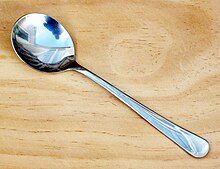
A stainless steel bouillon spoon

The stages of the handforging process.
It is then heated until red hot and held in tongs and using the hammer and anvil, beaten into shape. The tip of the bar is pointed to form the tip of the bowl, then hammered to form the bowl. If a heel is to be added, a section down the centre is left thicker. The edges of the bowl and the tip of the spoon are left thicker as this is where most of the thickness is needed. The handle is then started and hammered out to length going from thick at the neck and gradually tapering down in thickness giving a balanced feel. During this process the piece becomes very hard and has to be annealed several times, then worked again until the final shape is achieved.
The bowl is filed to shape, often using a metal template. The bowl is then formed using a tin cake and spoon stake. The molten tin is poured around the spoon stake and left to harden. The handle is then bent down to 45 degrees, and the spoon is hammered into the tin using the spoon stake and a heavy hammer, to form the bowl. The bend in the handle is then adjusted to match the other spoons in the set and so it sits correctly on the table. The bowl is then filed level, a process called striking off. The surfaces are filed, first with a rough file to remove the fire stain from the surface, then with a smooth file. It is then buffed to remove any file marks and fire stain from inside the bowl and is polished to the desired finish.
Spoon
From Wikipedia, the free encyclopedia
Jump to: navigation, search
This article is about the utensil. For other uses, see Spoon (disambiguation).
A spoon is a utensil consisting of a small shallow bowl, oval or round, at the end of a handle. A type of cutlery (sometimes called flatware in the United States), especially as part of a place setting,
it is used primarily for serving. Spoons are also used in food
preparation to measure, mix, stir and toss ingredients. Present day
spoons can be made from metal (notably flat silver or silverware, plated or solid), wood, porcelain or plastic.Contents
Fruit development
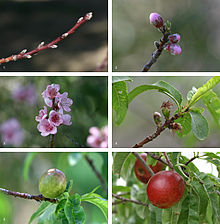
The development sequence of a typical drupe, the nectarine (Prunus persica) over a 7.5 month period, from bud formation in early winter to fruit ripening in midsummer (see image page for further information)
Main article: Fruit anatomy
A fruit results from maturation of one or more flowers, and the gynoecium of the flower(s) forms all or part of the fruit.[9]Inside the ovary/ovaries are one or more ovules where the megagametophyte contains the egg cell.[10] After double fertilization, these ovules will become seeds. The ovules are fertilized in a process that starts with pollination, which involves the movement of pollen from the stamens to the stigma of flowers. After pollination, a tube grows from the pollen through the stigma into the ovary to the ovule and two sperm are transferred from the pollen to the megagametophyte. Within the megagametophyte one of the two sperm unites with the egg, forming a zygote, and the second sperm enters the central cell forming the endosperm mother cell, which completes the double fertilization process.[11][12] Later the zygote will give rise to the embryo of the seed, and the endosperm mother cell will give rise to endosperm, a nutritive tissue used by the embryo.
As the ovules develop into seeds, the ovary begins to ripen and the ovary wall, the pericarp, may become fleshy (as in berries or drupes), or form a hard outer covering (as in nuts). In some multiseeded fruits, the extent to which the flesh develops is proportional to the number of fertilized ovules.[13] The pericarp is often differentiated into two or three distinct layers called the exocarp (outer layer, also called epicarp), mesocarp (middle layer), and endocarp (inner layer). In some fruits, especially simple fruits derived from an inferior ovary, other parts of the flower (such as the floral tube, including the petals, sepals, and stamens), fuse with the ovary and ripen with it. In other cases, the sepals, petals and/or stamens and style of the flower fall off. When such other floral parts are a significant part of the fruit, it is called an accessory fruit. Since other parts of the flower may contribute to the structure of the fruit, it is important to study flower structure to understand how a particular fruit forms.[3]
There are three general modes of fruit development:
- Apocarpous fruits develop from a single flower having one or more separate carpels, and they are the simplest fruits.
- Syncarpous fruits develop from a single gynoecium having two or more carpels fused together.
- Multiple fruits form from many different flowers.
Botanic fruit and culinary fruit

Euler diagram representing the relationship between (culinary) vegetables and botanical fruits
These culinary vegetables that are botanically fruit include cucurbits (e.g., squash, pumpkin, and cucumber), tomatoes, peas, beans, corn, eggplant, and sweet pepper. In addition, some spices, such as allspice and chilies, are fruits, botanically speaking.[6] In contrast, rhubarb is often referred to as a fruit, because it is used to make sweet desserts such as pies, though only the petiole of the rhubarb plant is edible.[7] Edible gymnosperm seeds are often given fruit names, e.g., pine nuts, ginkgo nuts.
Botanically, a cereal grain, such as corn, wheat or rice, is also a kind of fruit, termed a caryopsis. However, the fruit wall is very thin, and is fused to the seed coat, so almost all of the edible grain is actually a seed.[8]
Many common terms for seeds and fruit do not correspond to the botanical classifications. In botany, seeds are ripened ovules; fruits are the ripened ovaries or carpels that contain the seeds and a nut is a type of fruit and not a seed.[6]
Vegetable juice
Hot drinks

A cup of coffee
Fruit juice
Fruits are highly perishable so the ability to extract juices and store them was of significant value. Some fruits are highly acidic and mixing them with water and sugars or honey was often necessary to make them palatable. Early storage of fruit juices was labor intensive, requiring the crushing of the fruits and the mixing of the resulting pure juices with sugars before bottling.
Drink
From Wikipedia, the free encyclopedia
Jump to: navigation, search
For the act of consuming a beverage through the mouth, see Drinking.
|
|
This article needs additional citations for verification. Please help improve this article by adding citations to reliable sources. Unsourced material may be challenged and removed. (February 2011) |
Presentation
Main article: Food presentation
Aesthetically pleasing and eye-appealing food presentations can
encourage people to consume foods. A common saying is that people "eat
with their eyes". Food presented in a clean and appetizing way will
encourage a good flavor, even if unsatisfactory.[19][20]Contrast in texture
Texture plays a crucial role in the enjoyment of eating foods. Contrasts in textures, such as something crunchy in an otherwise smooth dish, may increase the appeal of eating it. Common examples include adding granola to yogurt, adding croutons to a salad or soup, and toasting bread to enhance its crunchiness for a smooth topping, such as jam or butter.[21]Contrast in taste
Another universal phenomenon regarding food is the appeal of contrast in taste and presentation. Opposite flavors, such as sweet and saltiness, tend to go well together, such as in kettle corn and with nuts.Animals

Various raw meats
Main articles: Animal source foods and Food chain
Animals are used as food either directly or indirectly by the products they produce. Meat is an example of a direct product taken from an animal, which comes from muscle systems or from organs. Food products produced by animals include milk produced by mammary glands, which in many cultures is drunk or processed into dairy products (cheese, butter, et cetera). In addition, birds and other animals lay eggs, which are often eaten, and bees produce honey, a reduced nectar from flowers, which is a popular sweetener in many cultures. Some cultures consume blood, sometimes in the form of blood sausage, as a thickener for sauces, or in a cured, salted form for times of food scarcity, and others use blood in stews such as jugged hare.[8]Some cultures and people do not consume meat or animal food products for cultural, dietary, health, ethical, or ideological reasons. Vegetarians do not consume meat. Vegans do not consume any foods that are or contain ingredients from an animal source.
Food
From Wikipedia, the free encyclopedia
Jump to: navigation, search
For other uses, see Food (disambiguation).
Food is any substance[1] consumed to provide nutritional support for the body. It is usually of plant or animal origin, and contains essential nutrients, such as carbohydrates, fats, proteins, vitamins, or minerals.
The substance is ingested by an organism and assimilated by the
organism's cells in an effort to produce energy, maintain life, or
stimulate growth.Historically, people secured food through two methods: hunting and gathering, and agriculture. Today, most of the food energy consumed by the world population is supplied by the food industry.
Food safety and food security are monitored by agencies like the International Association for Food Protection, World Resources Institute, World Food Programme, Food and Agriculture Organization, and International Food Information Council. They address issues such as sustainability, biological diversity, climate change, nutritional economics, population growth, water supply, and access to food.
The right to food is a human right derived from the International Covenant on Economic, Social and Cultural Rights (ICESCR), recognizing the "right to an adequate standard of living, including adequate food", as well as the "fundamental right to be free from hunger".
Types of religion
Further information: History of religions
Categories
Some scholars classify religions as either universal religions that seek worldwide acceptance and actively look for new converts, or ethnic religions that are identified with a particular ethnic group and do not seek converts.[36] Others reject the distinction, pointing out that all religious practices, whatever their philosophical origin, are ethnic because they come from a particular culture.[37][38][39]In the 19th and 20th centuries, the academic practice of comparative religion divided religious belief into philosophically defined categories called "world religions." However, some recent scholarship has argued that not all types of religion are necessarily separated by mutually exclusive philosophies, and furthermore that the utility of ascribing a practice to a certain philosophy, or even calling a given practice religious, rather than cultural, political, or social in nature, is limited.[40][41][42] The current state of psychological study about the nature of religiousness suggests that it is better to refer to religion as a largely invariant phenomenon that should be distinguished from cultural norms (i.e. "religions").[43]
Some academics studying the subject have divided religions into three broad categories:
- world religions, a term which refers to transcultural, international faiths;
- indigenous religions, which refers to smaller, culture-specific or nation-specific religious groups; and
- new religious movements, which refers to recently developed faiths.[44]
Origins and development
Main article: Theories of religion

The Yazılıkaya sanctuary with the twelve gods of the underworld
Many of the great world religions appear to have begun as revitalization movements of some sort, as the vision of a charismatic prophet fires the imaginations of people seeking a more comprehensive answer to their problems than they feel is provided by everyday beliefs. Charismatic individuals have emerged at many times and places in the world. It seems that the key to long-term success – and many movements come and go with little long-term effect – has relatively little to do with the prophets, who appear with surprising regularity, but more to do with the development of a group of supporters who are able to institutionalize the movement.[33]The development of religion has taken different forms in different cultures. Some religions place an emphasis on belief, while others emphasize practice. Some religions focus on the subjective experience of the religious individual, while others consider the activities of the religious community to be most important. Some religions claim to be universal, believing their laws and cosmology to be binding for everyone, while others are intended to be practiced only by a closely defined or localized group. In many places religion has been associated with public institutions such as education, hospitals, the family, government, and political hierarchies. Anthropologists John Monoghan and Peter Just state that, "it seems apparent that one thing religion or belief helps us do is deal with problems of human life that are significant, persistent, and intolerable. One important way in which religious beliefs accomplish this is by providing a set of ideas about how and why the world is put together that allows people to accommodate anxieties and deal with misfortune."[34]
One modern academic theory of religion, social constructionism, says that religion is a modern concept that suggests all spiritual practice and worship follows a model similar to the Abrahamic religions as an orientation system that helps to interpret reality and define human beings,[35] and thus religion, as a concept, has been applied inappropriately to non-Western cultures that are not based upon such systems, or in which these systems are a substantially simpler construct.
Religion
From Wikipedia, the free encyclopedia
Jump to: navigation, search
This article is about a general set of beliefs about life, purpose, etc.. For other uses, see Religion (disambiguation).
"Religious" redirects here. For a member of a Catholic religious institute, see Religious (Catholicism).

Symbols from twelve world religious movements.
Row 1: Bahá'í Faith, Buddhism
Row 2: Christianity, Chinese folk religion, Hinduism, Islam
Row 3: Jainism, Judaism, Paganism, Shinto
Row 4: Sikhism, Taoism
Row 1: Bahá'í Faith, Buddhism
Row 2: Christianity, Chinese folk religion, Hinduism, Islam
Row 3: Jainism, Judaism, Paganism, Shinto
Row 4: Sikhism, Taoism
| Religions by country |
|---|
|
South America[show]
Middle East[show]
Oceania[show]
|
Many religions may have organized behaviors, clergy, a definition of what constitutes adherence or membership, holy places, and scriptures. The practice of a religion may also include rituals, sermons, commemoration or veneration of a god, gods or goddesses, sacrifices, festivals, feasts, trance, initiations, funerary services, matrimonial services, meditation, prayer, music, art, dance, public service or other aspects of human culture. Religions may also contain mythology.[2]
The word religion is sometimes used interchangeably with faith or belief system; however, in the words of Émile Durkheim, religion differs from private belief in that it is "something eminently social".[3] A global 2012 poll reports that 59% of the world's population is religious, 23% are not religious, and 13% are atheists.[4]
Langganan:
Postingan (Atom)
